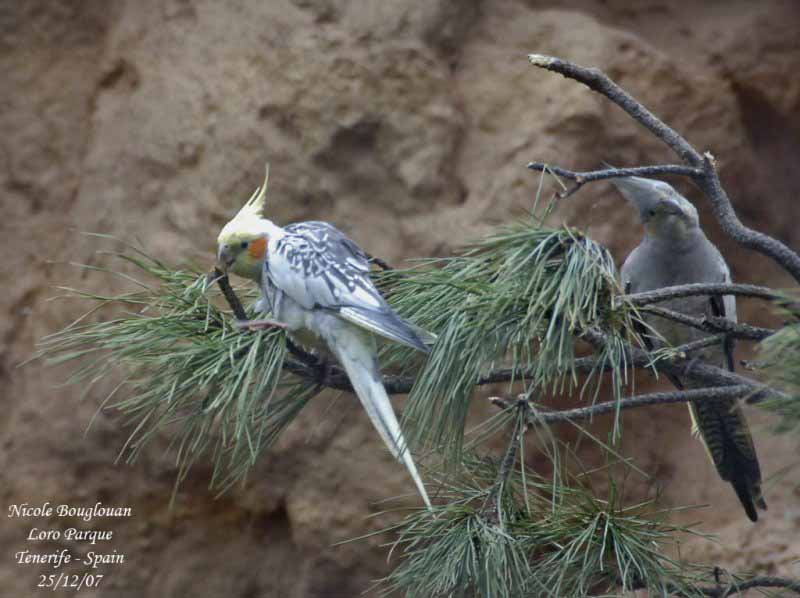
Cockatiel
Nymphicus hollandicus
Psittaciforme Order – Cacatuidae Family
BIOMETRICS:
Length: 32-33 cm; Weight: M : 80-100 g
LONGEVITY: up to 20 years
DESCRIPTION:
Cockatiel is a small cockatoo endemic to Australia.
Adult male has grey plumage overall. Upperwing is grey with conspicuous white patch. Long tail is grey, with longer and paler central tail feathers. Flight feathers, tail feathers and rump are paler grey than mantel.
On the underparts, throat, breast, belly and vent are grey. Underwing and undertail are darker.
On the head, face is yellow, with orange-red ear-coverts. Long, tapering crest is pale grey, washed yellow and with yellow edges. This crest may be vertical, oblique or flattened, according to the moment.
Hooked bill is grey. Eyes are dark brown. Legs and feet are grey.

Cockatiel adult female resembles male on the upperparts, but she has lower back, rump and central tail feathers pale grey, finely barred with white and yellowish. Outer tail feathers are yellow above and below.
On the underparts, throat, breast and upper belly are pale grey. Lower belly, undertail coverts and outer tail feathers are grey, barred with yellow. Central tail feathers are dark grey. On the grey underwing, flight feathers (primaries and secondaries) are barred pale yellow.
The head is greyer than in male, with crown, crest and cheeks pale grey washed yellow, and dull orange-red ear-coverts.
Juvenile is similar to female, but it has horn-coloured and grey bill. It reaches its sexual maturity between 18 months and two years of age.
We can find several colour mutations in captivity.
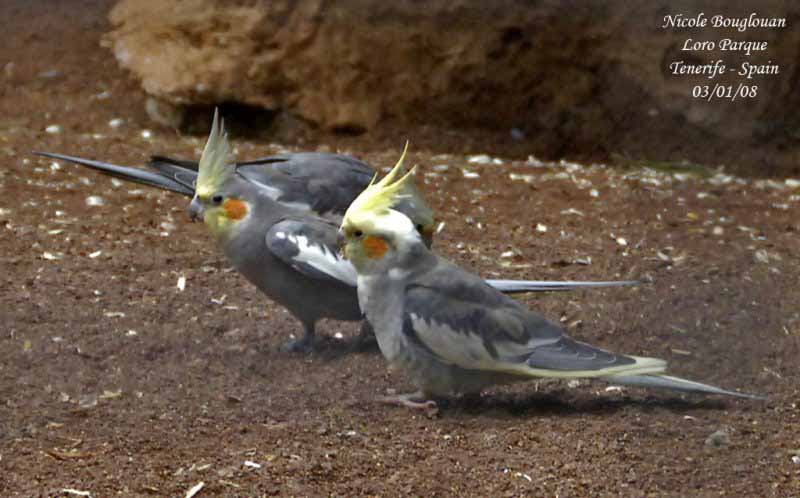
VOICE: SOUNDS BY XENO-CANTO
Cockatiel utters long “queel-queel…queel-queel” in flight. Alarm call is a low “wee-urp…wee-urp”. Distress call is a long screech.
Cockatiel is able to mimicry varied sounds, noises and other birds’ calls.
HABITAT:
Cockatiel can be seen up to 400 metres of elevation. It can frequent suburban areas and parks, crops, countries with scattered trees, farmlands, savannahs, arid and semi-arid open countries, grasslands and open woodlands, near water.
RANGE:
Cockatiel lives in the interior of mainland Australia.
BEHAVIOUR:
Cockatiel feeds on seeds of varied plants, but mainly Acacia seeds. It also consumes grains, fruits and berries.
It is usually seen in small or large groups feeding silently on the ground. But this species is noisy in flight.
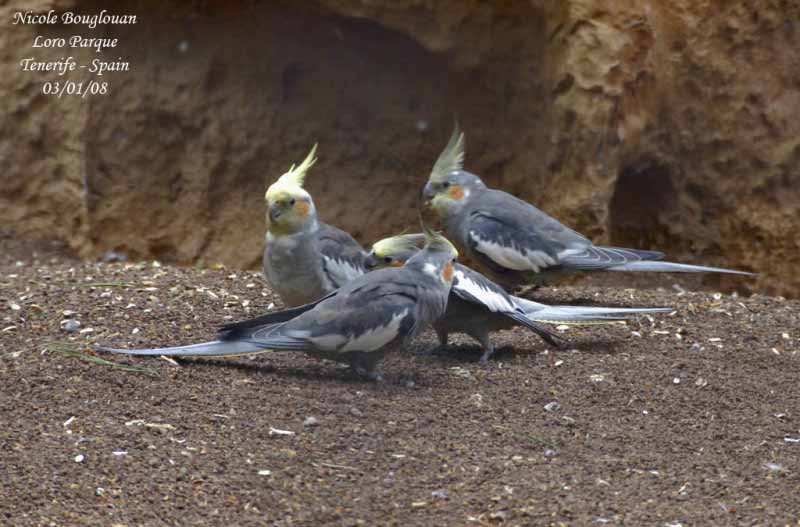
Cockatiel usually perches on dead treetop or on power lines, in group which each member adopts the same position that the other birds, all facing at the same direction into the wind.
Cockatiel sleeps at night in communal roosts, hidden in trees with dense foliage. They leave the roost in the early morning before sunrise.
Cockatiel forms large flocks outside breeding season. At this moment, they are nomadic and they wander, according to the seeding of grasses and cultivated plants.
Northern birds are highly nomadic, whereas southern populations migrate, arriving in spring for breeding, and migrating in the early following year.
Large flocks of Cockatiels are considered as pests by farmers because they damage the crops.
FLIGHT:
Cockatiel is a strong flier, performing swift and direct flight. White wing patches are very conspicuous in flight.
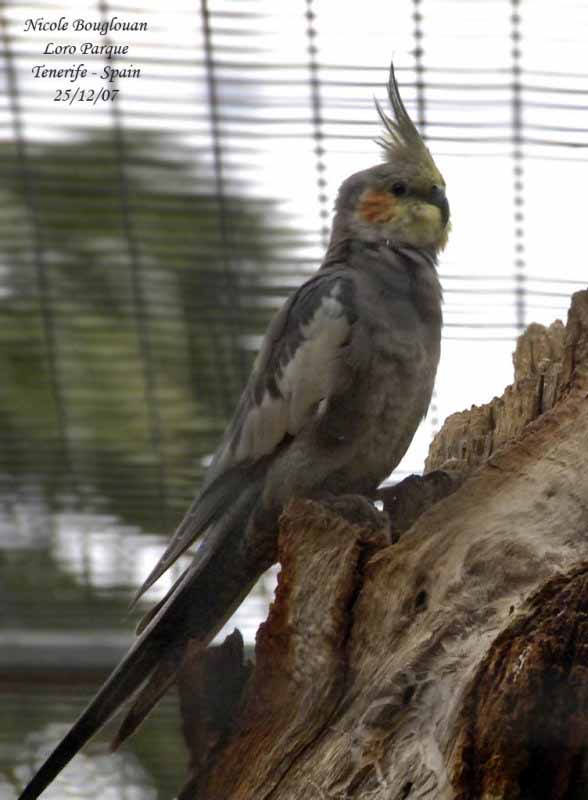
REPRODUCTION:
Breeding season occurs from August to December, sometimes as soon as April. It depends on weather conditions, particularly rainfalls.
Nest is placed in tree hollow, often eucalyptus species, near or in water.
Cockatiel enters tail first into the hollow, because it has very long tail.
The hollow is lined with wood dust, without particular care.
Female usually lays 4 to 7 white eggs. Incubation lasts about three weeks, shared by both parents, female the night, and male during the day.
At hatching, chicks are covered in thick yellow down. They are fed by both adults, and leave the nest about 4 to 5 weeks after hatching. Young grow quickly and can join nomadic flocks very soon.
This species can produce several broods per season.
DIET:
Cockatiel feeds on seeds, mainly acacia seeds, but also of native and cultivated plants, grains, fruits and berries. It usually forages on the ground twice a day. It needs to drink regularly, and this species is often seen near water.
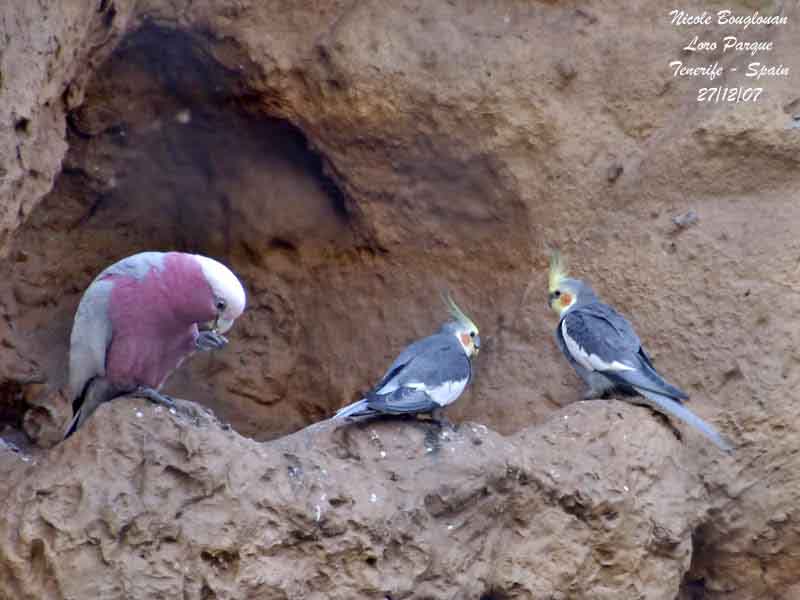
PROTECTION / THREATS / STATUS:
Cockatiel is abundant, but the large flocks are regarded as pests by farmers, and sometimes, these birds are killed under permit.
Cockatiel is a popular cage bird, and breeds very well in captivity throughout the world. Several mutations are now recognized.
Fr: Calopsitte élégante
All : Nymphensittich
Esp : Cacatúa Ninfa
Ital : Calopsitte
Nd : Valkparkiet
Russe : Нимфовый попугайчик
Text and pictures by Nicole Bouglouan
Photos taken in Loro Parque – Tenerife – Canary Islands - Spain
Sources:
HANDBOOK OF THE BIRDS OF THE WORLD volume 4 by Josep del Hoyo, Andrew Elliot and Jordi Sargatal – LYNX EDICION – ISBN 8487334229
PARROTS OF THE WORLD – An Identification Guide – by Joseph M. Forshaw – Princeton University Press – ISBN 0691092516
Wikipedia (Wikipedia, The Free Encyclopedia)
Animal Diversity Web (University of Michigan Museum of Zoology)